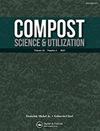有机材料蚯蚓堆肥过程中狼Eisenia foetida繁殖效率及基质变化
IF 0.9
4区 农林科学
Q3 ECOLOGY
引用次数: 9
摘要
摘要蠕虫堆肥是指通过蠕虫(通常是Eisenia foetida)消化有机基质的过程。基质的理化特性和蚯蚓的健康状况是蚯蚓有效堆肥的重要参数。本研究评价了蚯蚓堆肥处理不同基质混合物对粪足线虫繁殖效率和繁殖率的影响,以及蚯蚓堆肥处理对粪足线虫EC、pH、有机C、总氮和C:N比值的影响。试验采用完全随机设计,共10个处理,4个重复。分别对羊和马的粪便进行单独测试,并将苜蓿和麦秸的残留物按50%和75%混合。麦秸单独进行试验,并以75%的比例与25%的鸡粪混合。将E. foetida添加到混合物中,并允许处理基质混合物三个月。测定蚓粪的最终EC、pH、有机C和N水平,以及蚓粪的繁殖效率和繁殖率。成品蚯蚓堆肥的所有测量特性都因基质的不同而有显著差异。蚯蚓堆肥过程中基质也有不同程度的变化。总C和EC均升高;pH、总氮和C:N均呈下降趋势,其中25%苜蓿+ 75%羊粪混合堆肥的EC变化最大,为12.8 dS。初始为m-1, dS为18.6。成品蚯蚓堆肥中的M-1。总体而言,在制备蚯蚓堆肥过程中,pH降低,EC增加。本文章由计算机程序翻译,如有差异,请以英文原文为准。
Reproduction Efficiency of Eisenia foetida and Substrate Changes During Vermicomposting of Organic Materials
ABSTRACT Vermicomposting is the processing of organic substrates through digestion by worms, usually Eisenia foetida. The physico-chemical characteristics of the substrates and health of the worms are important parameter for effective vermicomposting. This study assessed reproduction efficiency and reproductive rate of E. foetida and changes in EC, pH, organic C, total Nitrogen and C:N ratio by vermicomposting different substrate mixtures. The study was performed as a completely randomized design with 10 treatments and 4 replicates. Manures from sheep and horse were tested alone and mixed at 50 and 75% with residues of alfalfa and wheat straw. Wheat straw was also tested alone and mixed at 75% with 25% chicken manure. E. foetida were added to the mixtures and allowed to process the substrate mixtures for three months. Final EC, pH, organic C and N levels of vermicompost were measured, as well as the reproductive efficiency and reproductive rate of the E. foetida. All measured characteristics of the finished vermicompost were significantly different depending on substrate. Substrates also changed to differing degrees during vermicomposting. Total C and EC increased in all substrates; and pH, total N, and C:N decreased in all substrates during vermicomposting The greatest change of EC was in the 25% alfalfa + 75% sheep manure mixture, which was 12.8 dS.m-1 initially and 18.6 dS.m-1 in finished vermicompost. Overall, pH declined and EC increased during the preparing of vermicompost.
求助全文
通过发布文献求助,成功后即可免费获取论文全文。
去求助
来源期刊

Compost Science & Utilization
农林科学-生态学
CiteScore
4.10
自引率
0.00%
发文量
0
审稿时长
>36 weeks
期刊介绍:
4 issues per year
Compost Science & Utilization is currently abstracted/indexed in: CABI Agriculture & Environment Abstracts, CSA Biotechnology and Environmental Engineering Abstracts, EBSCOhost Abstracts, Elsevier Compendex and GEOBASE Abstracts, PubMed, ProQuest Science Abstracts, and Thomson Reuters Biological Abstracts and Science Citation Index
 求助内容:
求助内容: 应助结果提醒方式:
应助结果提醒方式:


